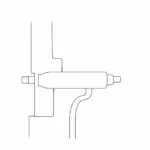The OBD2 code B1000 is a common trouble code that can be quite perplexing for car owners. This code indicates a problem with the Body Control Module (BCM) communication circuit. The BCM is essentially your car’s brain, responsible for managing a wide range of electrical and electronic components, including:
- Lighting (headlights, taillights, interior lights)
- Power windows and door locks
- Security system
- Air conditioning and heating
- Wipers
- Horn
- Instrument cluster
When the communication circuit of the BCM encounters an issue, it can disrupt the functionality of any of these systems, leading to a variety of symptoms.
What Does OBD2 Code B1000 Mean?
The code B1000 specifically points to a general communication failure within the BCM itself or between the BCM and other control modules in the vehicle. This communication occurs through the Controller Area Network (CAN bus), a network system that allows various modules to share information.
Imagine the CAN bus as a network of roads connecting different parts of a city, and the BCM as the central hub managing traffic flow. A communication breakdown is like a road closure, disrupting the smooth exchange of information and potentially causing chaos in the city’s operations.
Common Causes of OBD2 Code B1000
Several factors can contribute to a B1000 code, ranging from simple electrical glitches to more complex wiring problems. Here are some of the most common culprits:
- Loose or corroded battery terminals: A poor connection at the battery can disrupt the electrical supply to the BCM.
- Damaged or faulty BCM: Over time, the BCM itself can malfunction due to wear and tear, exposure to moisture, or electrical surges.
- Wiring issues: Open or shorted circuits in the BCM wiring harness can impede communication.
- Faulty CAN bus wiring: Problems with the CAN bus wiring, such as breaks or shorts, can disrupt communication between the BCM and other modules.
- Software glitches: In some cases, a software error within the BCM can trigger the B1000 code.
Symptoms of a B1000 Code
The symptoms associated with a B1000 code can vary widely depending on the specific vehicle make and model and the underlying cause of the communication failure. However, some common signs include:
- Warning lights on the dashboard: The check engine light, ABS light, or other warning lights may illuminate.
- Malfunctioning electrical components: Problems with lights, windows, locks, or other electrical systems controlled by the BCM may arise.
- Erratic vehicle behavior: The engine may stall, run rough, or experience performance issues.
- Issues with starting the vehicle: In some cases, the car may not start at all.
How to Diagnose and Fix OBD2 Code B1000
Diagnosing and fixing a B1000 code typically requires a systematic approach:
- Read the code: Use an OBD2 scanner to retrieve the specific code stored in your vehicle’s computer. This will confirm the presence of the B1000 code and may also reveal other related codes.
- Check the battery and terminals: Inspect the battery terminals for looseness, corrosion, or damage. Clean or tighten them as needed.
- Inspect the BCM wiring harness: Visually examine the wiring harness connected to the BCM for any signs of damage, such as fraying, cuts, or burns.
- Check for CAN bus issues: If the wiring harness appears intact, use a multimeter to test the continuity of the CAN bus wiring.
- Test the BCM: If the previous steps don’t reveal the cause, the BCM itself may be faulty and require testing or replacement.
“When diagnosing a B1000 code, it’s crucial to rule out simple issues like battery connections and wiring problems before suspecting a faulty BCM,” advises John Smith, Senior Automotive Technician at CarDiagTech Workshop. “Replacing the BCM can be costly, so thorough diagnostics are essential.”
Conclusion
The OBD2 code B1000, indicating a communication problem within the BCM circuit, can lead to various vehicle malfunctions. While the code itself can seem daunting, understanding its meaning and following a systematic diagnostic approach can help pinpoint the root cause and lead to an effective solution. Remember to consult a qualified mechanic if you’re unsure about any step of the diagnostic process or require assistance with repairs.
FAQs
Q: Can I still drive my car with a B1000 code?
A: While you might be able to drive short distances, it’s not advisable. The B1000 code signifies a potential issue with your car’s essential systems, and continuing to drive could exacerbate the problem or lead to more serious complications.
Q: How much does it cost to fix a B1000 code?
A: The repair cost can vary greatly depending on the underlying cause. Simple fixes like cleaning battery terminals or tightening connections might cost only a few dollars. However, if the BCM needs replacement, the cost can range from a few hundred to over a thousand dollars, depending on the make and model of your vehicle.
Q: Can I fix a B1000 code myself?
A: If you’re comfortable with basic car maintenance, you might be able to handle simple fixes like battery terminal cleaning or checking for loose connections. However, diagnosing and repairing more complex issues like wiring problems or a faulty BCM often require specialized tools and knowledge, and seeking professional help is recommended.
Need further assistance with your car’s OBD2 codes or have other automotive concerns? Contact our team of experts via WhatsApp: +1(641)206-8880 or Email: [email protected]. We provide 24/7 support to help you get back on the road safely.


